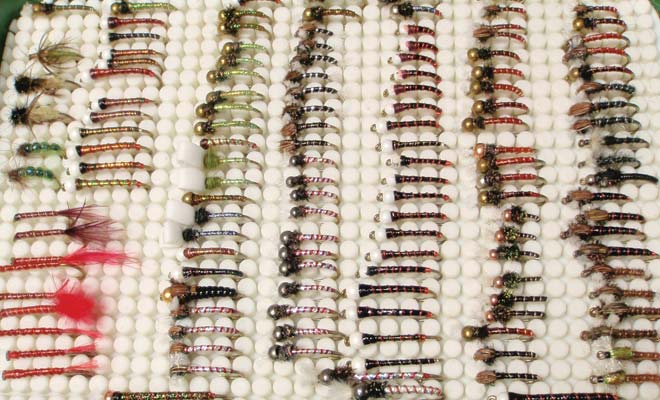
Flies for Alaska Lakes
In the February 2014 issue of the Fish Alaska stillwater column I wrote that in general it’s not the fly that produces consistent success in lakes. This holds true for most of the season, as trout in southcentral Alaska’s lakes are generally opportunistic feeders. However, there is a short period of time each spring when sometimes it is the fly.
Timing
The ice usually leaves the lowland lakes sometime during the first week of May. It takes a short time for the water to warm and then the seasonal insect hatches and migrations begin. The first major hatch in most lakes is chironomids. They will start hatching before the lakes are completely ice-free, but the peak period in southcentral Alaska’s lakes is from about a week and a half after the ice is completely gone through the middle of June.
The Fly
Trout in Alaska’s lakes are seldom picky about the flies they’ll bite. However, sometimes during a heavy chironomid hatch they will become selective. I’ve experienced extremely slow bites during heavy chironomid hatches while trying to convince the trout to bite a leech, soft hackle or other impressionistic nymph, but during the same day I also experienced phenomenal fishing when I switched to a chironomid pupa and offered the appropriate presentation.
Chironomid pupa imitations are widely used outside of Alaska for trout. In Alaska, though, I’ve encountered few fisherman in the past 20 years who fished chironomid pupa imitations regularly. It could be that the fish are usually not selective, and that our chironomid fishing is best primarily during a relatively short window in spring and early summer. Regardless, I will not be on the water from ice-out to mid-June without chironomid pupa imitations and the means to fish them.
Although chironomid imitations are commonly tied in sizes 8 through 18 outside of Alaska, I typically stock my boxes with larger imitations in the size 8 to 14 range. If I had to pick a single pupa imitation for Alaska’s lakes, I’d pick a size 12 Ice Cream Cone in black with a red rib. Still, my chironomid box has several colors (black, olive, green, brown) and several sizes, just in case the fish want something a little more specific. In lakes outside Alaska, both color and size are often important, as the fish get a lot of pressure in the better lakes. That’s not the case here, and if your imitation is reasonable in size and color it will get eaten.
Presentation
For most of my stillwater fly fishing, I use an intermediate line and a tapered leader. I present the fly horizontally through the water column. However, this doesn’t workwell for imitating chironomid pupae. Chironomids ascend to the surface slowly and vertically, and sometimes hang in a vertical orientation in the water column for periods of time. To imitate chironomid pupa there are two presentations that work best. It is very helpful to anchor when employing either of these techniques.
The first involves using a floating fly line, a long, un-tapered leader of six- or eight-pound monofilament up to 18 feet long, a quick-release strike indicator, a few feet of 3x or 4x fluorocarbon tippet and your pupa imitation. This floating line technique works in water up to 20 feet deep. Simply place your indicator at the depth you think the fish are feeding, cast it out and wait for the indicator to go down. I usually start with my fly about a foot and a half off the bottom. If I don’t get bit, I start shortening the distance between the fly and indicator until I start getting bites.
The second presentation method is for fishing water deeper than 20 feet. It involves using a fast-sinking fly line (I usually use a type III or type IV) and a short leader of four- or five feet of 3x or 4x fluorocarbon, plus your pupa imitation. To execute this technique, anchor and then attach a pair of forceps or some other weight to your fly. Put your rod tip in the water and strip out line until your forceps or weight hit bottom. Then wind in two reel-turns of line and strip the rest of the line in to remove the forceps or weight. Cast all of the line out and let it sink until it’s hanging straight up and down. Your fly will now be about a foot and a half above the bottom. Let it sit for 30 seconds, and then begin inching it ever so slowly towards the surface. My usual retrieve is four one-inch pulls about a second apart, a pause of 20 seconds or so, and then I repeat the sequence until I can see my leader. Expect bites from the time you cast until you can see your fly line/leader junction. The takes can be very aggressive using this technique. Make sure you have a good grip on the rod!
Not all lakes experience periods of selective feeding, but some lakes with heavy chironomid hatches during spring and early summer do. During these time periods, it can definitely be the fly and corresponding presentation that matters most.
###
George Krumm is a contributing editor for Fish Alaska magazine; he can be reached at george@fishalaskamagazine.com.
